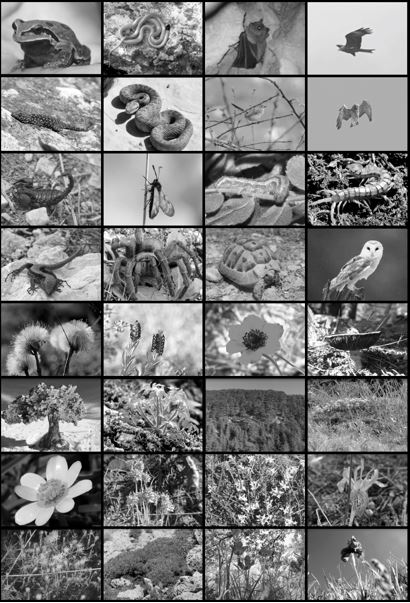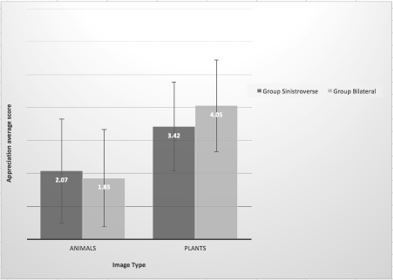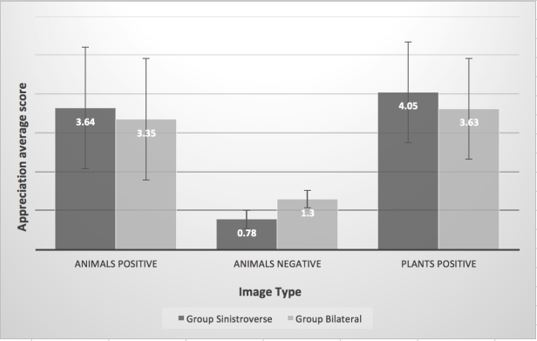Biography
Interests
Fenianos Johnny1,2, Khater Carla2* & Brouillet Denis1
1University Paul Valéry, Laboratoire Epsylon, Montpellier, France
2Center for Remote Sensing- National Council for Scientific Research Lebanon, Lebanon
*Correspondence to: Dr. Khater Carla, Center for Remote Sensing- National Council for Scientific Research Lebanon, Lebanon.
Copyright © 2018 Dr. Fenianos, et al. This is an open access article distributed under the Creative Commons Attribution License, which permits unrestricted use, distribution, and reproduction in any medium, provided the original work is properly cited.
Abstract
Communicating with key stakeholders is an essential factor of success in all environmental projects.
Literature findings confirm that laterality and in particular writing/reading habits play a crucial
role in modifying perceptions. In this paper, we test the influence of reading/writing habits on
the expression of the visual appreciation of an image, on two groups of 40 right-handed Lebanese
students (sinistroverse vs. bilateral readers/writers) aged 16 to 19. Lebanon is a multicultural country
where students study either exclusively in Arabic or are exposed to both Arabic and French, and/
or English cultures. 32 images of common flora (plants) and fauna (animals) that could be used in
quarry rehabilitation projects, were displayed on a computer screen for appreciation and the results
showed that, in the case of exclusively Arabic speaking target communities, using adapted tools could allow a better expression of the true perceptions of a community. When it comes to the
successful implementation of environmental projects, our results open the floor, to the necessity
of understanding lateral perception of target communities especially in terms of reading/writing
direction, in adapting the tools during public hearings and presentations.
Introduction
Ecologists have always needed to communicate their results, questions and findings or to share and discuss
the various elements of a project.
To a question raised in Miller and Hobbs (2007) [1] on how much more ecology is needed, Khater et al. (2012) replied that, not only more ecology is needed, but also more social involvement [2]. Khater (2015) has stressed on the importance to develop a science on the interface and strengthen inter-disciplinary communication [3]. More recently Ramirez et al. (2018) [4], echoing Courchamp & Bradshaw (2018) [5] and Tallis & Lubchenco (2014) [6] confirm the importance of effective social interactions and the need for a more inclusive ecology.
It is now well established that visual space perception is asymmetric. That is to say that the ability to appreciate objects is laterality space dependent. According to Cassasanto (2009) objects are more easily detected when they appear on the right side of a surface than on its left [7]. This perceptual asymmetry results on the brain’s preference response to visual stimuli [8]. Nicholls, Bradshaw, & Mattingley (2001) [9] and Bradshaw et al. (1987) [10] have estimated that the left bias might be a consequence of the over activation of the right hemisphere of the brain. While studying the cultural influences on visual scanning patterns, Abed (1991) has demonstrated that the cross-cultural differential visual perceptions are not related to location of fixations by the retina [11]. Thereby Fagard & Dahmen (2003) have compared the effect of reading and writing directions between French and Tunisian children and confirmed the effect of writing directions, i.e. dextroverse (L-R) and sinistroverse (R-L), on spatial visual perception [12].
Manual dominance is one of the main specificities of the body. The results observed in studies of typing activity showed that skilled typists on the QWERTY keyboard preferred letters typed with the right hand to those typed with the left hand. But when participants were asked to perform the preference task while holding a motor plan in memory (i.e., dual task) the skilled typists’ preference was attenuated when the motor plan involved the same finger used to type the presented dyads [13]. Jasmin & Casasanto (2012) confirmed that preference judgments are influenced by motor fluency caused by digit-specific typing simulation (the socalled QWERTY effect) [14]. At last, Yang, Gallo and Beilock (2009) showed that the fluency with which participants type the letter dyads to be recognized influences their recognition judgement [15]. Participants found it easier to remember letter dyads typed with two different fingers than those typed with one finger. Indeed, typing a letter dyad with two different fingers is easier than typing a letter dyad with one finger.
If manual dominance is one of the main body specificities, laterality is another one: an individual’s most fluent actions are those executed with the dominant hand on the dominant side (i.e. for a right-hander, movements of the right hand on the right side). Classic studies on aim-pointing tasks have already demonstrated that ipsilateral actions are carried out more easily and faster than contralateral actions for both the dominant and the non-dominant hand [16]. In other words, independently of handedness, the right hand should be more fluent on the right side of space than on the left part, and the left hand should be more fluent on the left part than on the right part of space [17]. Moreover, Milhau, Brouillet & Brouillet (2013, 2014) show that it is necessary to take into account the effect of the location of responses, by considering their congruence with the motor fluency experienced during the task rather than the motor fluency corresponding to the participant’s handedness [18,19].
All these studies support the ideas that motor compatibilities generate fluency and that the more fluently an item is processed the more it is considered familiar [20-24] and emotionally positive [25,26].
All this work led us to question the influence of writing directions on the perception of images, and more specifically their emotional evaluation, in relation with quarry rehabilitation in Lebanon. Indeed, the way people conceive the world is intrinsically dependent on body specificities and on the way they interact with their environment [7]. Two major factors have been highlighted: manual dominance and laterality. Since these two factors are intimately linked in the case of writing, they should both be taken into account.
Lebanon is an independent Republic located on the eastern coast of the Mediterranean Sea. Lebanon’s official language is Arabic, however, as a consequence of the former French Mandate on the country, the article 11 of the Constitution states that the French language is to be used on Lebanese pound banknotes, road signs, vehicle registration plates, and public buildings, alongside Arabic
Almost 40% of Lebanese are considered francophone, another 15% “partially francophone”, and 70% of Lebanon’s secondary schools use French as their language of instruction. By comparison, English is used as the language of instruction in 30% of Lebanon’s secondary schools. French and English are often taught since preschools in addition to Arabic [27].
The aim of this work is thus to determine if the influence of reading/writing habits (sinistroverse vs bilateral) affect the expression of visual appreciation of an image on a scale bar. To do that, and as recommended by Millhau et al. (2013, 2014) we have used two different appreciation scale bars: a regular Likert appreciation scale bar ranging from 0 (I totally dislike) on the right to 5 (I totally like) on the left for the “bilateral” group and an inverted scale bar used for the sinistroverse group adapted ranging from 0 (I totally dislike) on the left to 5 (I totally like) on the right, in order to test if the perception of the “I like” position is affected by the reading/writing habits of the two groups of participants [18,19].
Material and Methods
40 right handed Lebanese students aged between 16-19 were targeted by this study. 20 students were recruited
from Islamic University - Tyre/ South Lebanon and come from an exclusively Arabic speaking background
with no exposure to a second language, and 20 other students came from a bi-cultural background
(St Joseph University- Beirut) where Arabic and French are equally taught since preschool. Beirut being the
Capital of Lebanon and Tyre the capital of South Lebanon (4th biggest city in Lebanon).
In other terms, the members of the group coming from South Lebanon write exclusively from right to left “sinistroverse” group, while bilingual students, who represent the “bilateral” group in the frame of this study, can write alternatively from right to left and from left to right. Since Lebanon is a small scaled country relatively homogeneous in terms of socio cultural pressure, at the exception of language, both groups are composed of students living in cities and therefore exposed to comparable cultural and background. Participant’s dominant hand was assessed through the Ediburgh Handeness Inventory - Short Form [28]. All 40 participants were confirmed right handed.
32 stimuli images representing 16 flora (plants) and 16 fauna (animals) (Figure 1) were included in a preautomated
computer presentation. Images were selected in view of their potential use in quarry rehabilitation
projects. All images represent commonly known plants and animals in Lebanon. They are often used
in university presentations and they were pre-tested on a control group to ascertain that participants are
familiar with them. Each image was automatically displayed on the screen for a duration of 600ms alternating
randomly plants and animal’s images. After each image, a screen was displayed showing a non-graduated
appreciation scale bar of 5cm length. Two scale bars were used, a regular Likert scale bar used for the ‘bilateral”
group displaying on right side of the bar the word “I like” (rating 5) and on the left side of the bar the
word “I dislike” (rating 0), and an inverted Likert scale bar used for the sinistroverse group showing the “I
Like” (rating 5) on the right side and the “I dislike” (rating 0) on the left side.

Each session starts with a brief explanation provided by the researcher. In the beginning, a test image (not
used in the study) is provided to allow participants to get acquainted with reaction and display time. The
participants are invited to fill the evaluation sheet after each image is displayed on the screen. They are asked
to mark their appreciation of the image (to what extent they like or dislike it) on the appreciation scale bar.
The experiment starts with an “attention” white screen during 2000 ms, immediately followed by the image to be appreciated. Each image is displayed on the full screen for 600 ms. Between each image and the following, a blank screen appears for 2000 ms, followed by an “attention” white screen. An evaluation sheet is distributed to each participant (Figure 2). Each evaluation sheet shows 32 Likert appreciation bars (one for each image) showing the “I like” and “I dislike” positioned in view of the group they belong to.

Data Analysis
After the test, the sheets were collected and the scale bars were measured (in cm) in view of the position of
the mark for each image. Data was analyzed using Anova test with Jasp open-access platform ( https://jaspstats.org/). The results of the analysis were confronted to a 5% threshold for significance.
Variables tested are: type of images in intragroup (plants and animals); nature of the group (sinistroverse vs bilateral) in intergroup.
Results
Statistical intergroup analysis shows a significant difference between the appreciation of images of plants (m=3.73) and animals (m=1.96), F (1,38) = 144.30; p <0.01, n2p= 0.79.
Results do not show significant differences between the two groups “sinistroverse” m= 2.74 and “bilateral” m= 2.95, F (1,38) = 1.11, p= 0.29, n2p= 0.02 (Figure 3).

We note a large variability within groups (SD= 1.58 (animals), 1.35 (plants) for Sinistroverse group, and 1.47 (animals), 1.40 (plants) for Bilateral group) but this variability is comparable between the groups.
Statistical analysis shows interaction between the type of images and nature of the group, F (1,38) = 8.14, p= 0.007, n2p= 0.17.
The analysis of this interaction shows no significant difference for animal images evaluation between “sinistroverse” (m=2.07) and “bilateral” (m= 1.85) groups F (1,38) = 0.70, p=0.40, n2p= 0.01. However, the results show a significant difference for plants images evaluation between the two groups “sinistroverse” (m=3.42) and “bilateral” (m= 4.05), F (1,38) = 7.33, p=0.01, n2p= 0.16
Intragroup analysis shows a significant difference between animals (m=2.07) and plants (m=3.42) evaluation
for the sinistroverse group, F (1,19) = 116.40, p<0.001, n2p= 0.86
As well as a significant difference between animals (m=1.85) and plants (m=4.05) evaluation for the Bilateral group, F (1,19) = 39.96, p<0.001, n2p= 0.67
As results have showed a significant difference between perception of plants and animals and a significant
difference between the interactions within both groups (sinistroverse vs. bilateral), we have therefore questioned
the origin of this significant difference (Figure 4). Is it deriving from the type of images (animals and
plants) or rather from the evaluation itself?

We have therefore analyzed the perceptions (evaluation) of each type of image (animals and plants) to distinguish those perceived positively (above 2.5 being the median value of the suggested scale bar) from those perceived negatively (below the 2.5 median value).
This analysis shows no significant difference between the 2 groups for animal photos perceived positively: sinistroverse group (m=3.68) and bilateral group (m=3.43), F (1,38) = 0.68, p=0.45, n2p=0.01.
There is a significant tendency between the 2 groups for animal photos perceived negatively: sinistroverse group (m=0.78) and bilateral group (m=1.30), F (1,38) = 3.12, p=0.085, n2p= 0.07.
There is a significant difference between the 2 groups for plants photos perceived positively: sinistroverse group (m=4.40) and bilateral group (m=3.77) F (1,38) = 7.10, p=0.01, n2p= 0.16.
Figure 4 shows that animals can be perceived either positively (above the median) or negatively (below the median) while plants were only perceived positively by all participants.
Discussion
In the frame of a broader approach, aiming at communicating ecological findings to concerned stakeholders
in a more efficient way, and to identify whether regularly used tools need to be adapted to fit the communities’
specificities, a set of 32 images (plants and animals) that could potentially be used in quarry rehabilitation
were used for this study.
This paper aimed to test to what extent the reading/writing habits of participants (sinistroverse and bilateral) affect their evaluation of animal and plant images when faced with a Likert scale bar adapted to their reading/ writing habits running from left to right for the bilateral group and inverted from right to left for the sinistroverse group.
40 right handed Lebanese students aged between 16-19 were targeted by this study, they were recruited either from an exclusively Arabic speaking background (sinistroverse group) with no exposure to a second language, and from a bicultural background (bilateral group) where Arabic and French have equally been taught since preschool.
Participants were presented the 32 images (16 animals and 16 plants) and invited to fill an evaluation sheet to mark their appreciation of the image (to what extent they liked or disliked it) on an appreciation scale bar (adapted in view of the groups).
Results showed that
1. Both groups are comparable when it comes to appreciation of the whole set of images;
2. Animals and plants are not perceived in the same way: plants are perceived in a more positive way than
animals;
3. There is a significant interaction between the type of images and the nature of the groups, but the difference
between groups appear only for plant images (the “sinistroverse” group evaluates significantly more
positively the plant images than the “bilateral” group);
4. When we investigated the origin of the interaction, the results showed that this interaction could be explained
by the appreciation itself and not the type of images displayed. Results showed a significant difference
between the two groups. The sinistroverse group evaluated more positively the plant images evaluated
positively, and more negatively the animal images evaluated negatively.
Deriving from the literature findings highlighting the importance of laterality in evaluation, using coherent tools such as inverted Likert scale bar in the case of exclusively Arabic speaking target communities could allow a better expression of the true perceptions of a community. This can be particularly important in any project involving local communities and the need to consider their acceptability for an item (object, living organism, etc.) to be included in the project.
Our experiments highlight a previously unexplored cross-cultural difference in spatial perception and suggests a new interpretation in which communities that are exposed to more than one culture (bilateral group) tend to have less radical positions (whether liking or disliking an item), while monocultural individuals (here the sinistroverse group) show more stringent positions.
When it comes to the successful implementation of environmental projects, our results open the floor, to the necessity of using psycho cognitive tools that are adapted to local specificities and habits, especially in terms of reading/writing direction, during public hearings and public presentations. Our results could confirm a significant difference between exclusively Arabic speaking persons and bilingual persons in perceiving the appreciation bar, where the “I like” pole is situated at the left side of the bar, and the “I don’t like” is on the extreme right. This has to be nuanced by the fact that Arabic natives, who were never exposed to foreign languages throughout their education, are nevertheless exposed to biculturality through media and/or publicity and have therefore developed the ability to self-adapt to the tools presented to them.
Acknowledgment
This research is part of a PhD thesis of first author and part of two projects funded by Grant Research Program-
CNRS, and CEDRE Program. This is an LIA O-LiFE contribution number SA 42-2018.
The authors would like to acknowledge and thank Dr. Jalal Tabel for his support in data entry, and data structuring and Claire Grandchamps for editing the final version of this manuscript.
Disclosure Statement
“In these studies, we report all measures, manipulations and exclusions.”
Bibliography

Hi!
We're here to answer your questions!
Send us a message via Whatsapp, and we'll reply the moment we're available!